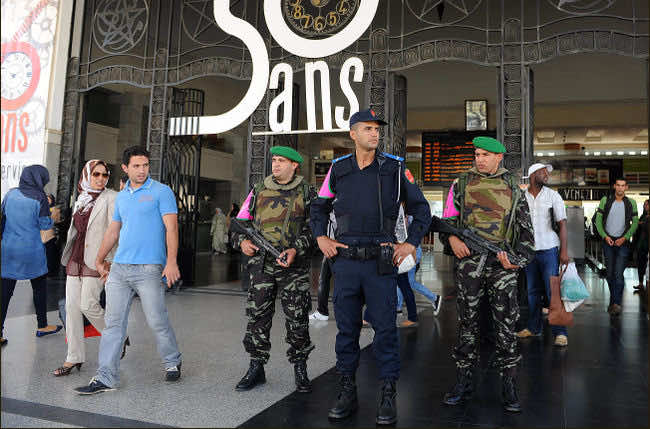![Hadar Alert Security Program Implemented]()
Marrakech - There is a thin line that separates laughter and pain, comedy and tragedy, humor and irony. Morocco lived through all of these in 2014 with tragic and joyful landmark events that left people sad at one moment and happy at another.
The following pictures and events of 2014 are engrained in every Moroccan citizen’s mind.
The Amendment of controversial rape marriage law
![ratification of rape law prosecution]()
On January 2014, the first chamber of the Moroccan parliament unanimously ratified a draft law to amend article 475 of the penal code that allowed rapists to avoid prosecution for rape if they married their victims.
The article in question made international headlines in March 2012 when Amina al-Filali, 16, was forced to marry a man who had allegedly raped her.
Right activists hailed the amendment. Now, Moroccan girls will no longer be forced into marriages with the people who physically and psychologically traumatize them.
Morocco's First Museum of Contemporary Art
The opening of Morocco's first museum since independence was among the best events that marked 2014. Dedicated to modern and contemporary art, the Mohammed VI Museum opened to the public on October 9th, 2014.
The Museum is located in the center of the capital city Rabat and it is a new addition to the city's numerous cultural venues, such as the National Library and the much-anticipated Grand Theatre of Rabat.
The Mohammed VI Museum first exhibition was a retrospective of over 400 art works that trace back the evolution of modern and contemporary art in the kingdom. 100 years of creation in Morocco attracted around 50,000 visitors to the Museum whose construction lasted 10 years.
Morocco’s Request to Postpone the Cup of African Nations
![Ebola- Morocco Calls for Postponing CAN 2015]()
Leery of the spread of Ebola, Morocco requested a postponement of the 2014 Cup of African Nations that was refused by the Confederation of African Football (FAC). The Confederation moved the CAN to Equatorial Guinea, instead of Morocco, which was subject to several punishments from the CAF
Floods that Devastated Southern Morocco
![Three Dead, 12 Missing Due to Floods in Southern Morocco]()
The south and south east of Morocco were inundated by unprecedented rain and flooding. More than 40 people died, many lost their homes with 23,600 houses damaged, and countless roads and bridges were destroyed.
Newly Renovated Moulay Abdellah Stadium in Rabat Washed Out by Rain
![Rabat- Heavy Rainfall Overwhelms Poorly Patched Football Pitch]()
When heavy rain flooded Rabat’s Moulay Abdellah Stadium during the 2014 Club World Cup, the primitive measures that were taken to drain the water out of the stadium involving using a big squeegee to soak up the water and squeeze it into buckets of well-known Moroccan paint companies, put Morocco under the critical eye of the world and damaging the reputation of Moroccan football.
Prince Moulay Rachid’s Wedding
![In Pictures- First Day of Prince Moulay Rachid’s Wedding]()
In contrast to the some sad events, 2014 saw the wedding of Prince Moulay Rachid, the younger brother of King Mohammed VI, to 27 year old Lalla Oum Keltoum Boufares in Rabat in November. Oum Keltoum Boufares is the daughter of Mamoun Boufares who was the governor of Marrakech when King Mohammed VI ascended the throne in July 1999.
Hadar Alert Security Program Implemented
![Hadar Alert Security Program Implemented]()
A new security program known as the “Hadar Alert” was created to counter security threats facing the Kingdom, including terrorist operations. The program, which was established on October 25, combines the forces of a police officer and two soldiers who are placed in strategic and vulnerable locations such as airports and tourist cities and sites.
The Bourgogne Disaster
![The Bourgogne Disaster]()
On Friday July 11, 2014 Moroccans woke up to the collapse of three buildings in the Bourgogne neighborhood of Casablanca.
The disaster took life of more than 22 citizens, and the injured were taken to the Moulay Youssef regional hospital where they were visited by King Mohammed VI.
“Medieval Morocco: An Empire from Africa to Spain”
![Bou Inania Madrasa in Fez, religion]()
Another landmark of 2014 was an exhibition entitled “Medieval Morocco: An Empire from Africa to Spain” which was inaugurated by Princess Lalla Meryem in Paris, on Tuesday, Oct. 17, 2014.
The Medieval Morocco exhibition, organized by the Louvre Museum in partnership with the National Foundation for Museums, promoted and preserved Moroccan culture.
It featured over 300 works of art reflecting what Morocco has achieved during the Almoravid, Almohad and Marinid dynasties in the fields of architecture, pottery, textiles, calligraphy, and books. The event also displayed scientific and technical inventions and their impact on the European Renaissance.
Allal 'Qadus', or Mustapha Smlali, The Hero of Rabat
![Allal 'Qadus', or Mustapha Smlali, The Hero of Rabat]()
After the heavy rain in Rabat and Casablanca, about two months ago, and in the absence of units in charge of streets drainage pipes, an old man in black shorts heroically volunteered to clean the drains of the streets and let rainwater drain into the pipes.
The old man rapidly was known throughout Morocco as Alla kadous “Allal of Pipes,” or the hero of Rabat, who ironically saved the Rabati people from floods.
Mustapha Smlali had been the headlines of Moroccan social media, as he managed allegedly to do more than the Civil Prevention Services could do.
© Morocco World News. All Rights Reserved. This material may not be published, rewritten or redistributed

![[AFP: Abdelhak Senna] Moroccans seek greater guidance from their imams and ulemas.](http://www.moroccoworldnews.com/wp-content/uploads/2013/10/AFP-Abdelhak-Senna-Moroccans-seek-greater-guidance-from-their-imams-and-ulemas..jpg)




























